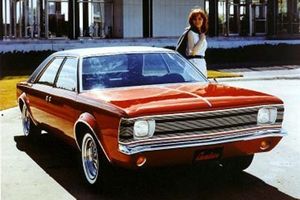.
AMC Cavalier: Difference between revisions
(Fixing tag) |
(Fixing tag) |
||
| Line 59: | Line 59: | ||
[[Category:AMC Vehicles|Cavalier]] | [[Category:AMC Vehicles|Cavalier]] | ||
[[Category:Concept | [[Category:Concept automobiles]] | ||
[[Category:Rambler Vehicles|Cavalier]] | [[Category:Rambler Vehicles|Cavalier]] | ||
[[Category:Rear Wheel Drive Vehicles]] | [[Category:Rear Wheel Drive Vehicles]] | ||
[[Category:1960s automobiles]] | [[Category:1960s automobiles]] | ||
Revision as of 14:09, 20 January 2007

| |
| AMC Cavalier | |
|---|---|
| AMC | |
| aka | |
| Production | |
| Class | |
| Body Style | |
| Length | |
| Width | |
| Height | |
| Wheelbase | |
| Weight | |
| Transmission | |
| Engine | |
| Power | |
| Similar | |
| Designer | |
A concept car built by American Motors (AMC) in 1965. It was part of three other prototypes that hinted at some of AMC's future production vehicles. In 1966, the Cavalier sedan became part of "Project IV" touring the the auto show circuit. This group of four show cars included the Vixen (a four passenger Coupé with a "flying buttress" rear roof pillar that made the rear window area a look similar to the 1966 Pontiac GTO), the AMX prototype (a two-seat coupe that evolved into the real production car), and the AMX II (a notch back hardtop that was eight inches longer than the AMX).
The Cavalier was unique in that it was a study in symmetry. It was built to demonstrate the use of numerous interchangeable body panels. For example, the left front and right rear fenders were identical. The doors were similarly shared with opposite sides since the rear doors were hinged in the back (suicide door). The hood and deck lid were also interchangeable. The objective was to reduce the costs of production.
Under the innovative body panel structure, the AMC Cavalier had a conventional front V8 engine (343 cubic inch displacement - 5621.8 cc.) with rear-wheel drive layout. The Cavalier had a 118 inch wheelbase (2997.2 mm) with a seating capacity for six passengers.
Many of the Cavalier's styling touches found their way into the AMC Hornet that was introduced for the 1970 model year. The Hornet was also designed under the direction of Richard A. Teague.
